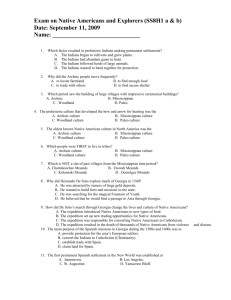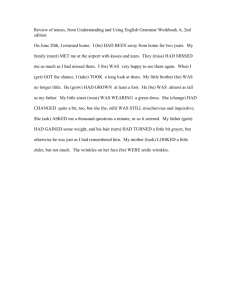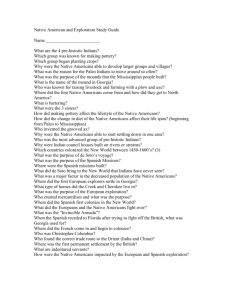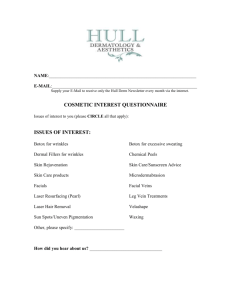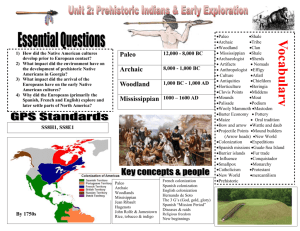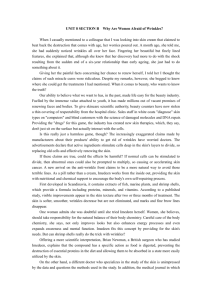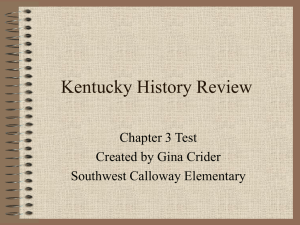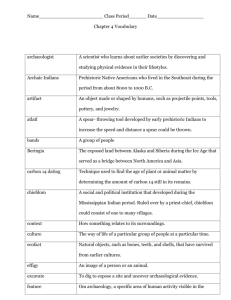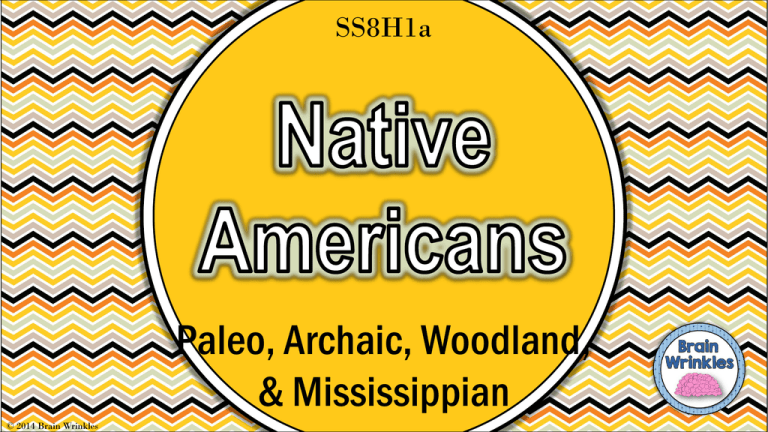
SS8H1a
Paleo, Archaic, Woodland,
& Mississippian
© 2014 Brain Wrinkles
Standards
SS8H1 The student will evaluate the development of Native
American cultures and the impact of European exploration and
settlement on the Native American cultures in Georgia.
a. Describe the evolution of Native American cultures (Paleo,
Archaic, Woodland, and Mississippian) prior to European contact.
contact.
© 2014 Brain Wrinkles
Teacher Directions – CLOZE Notes
• The next pages are handouts for the students to use for notetaking during the presentation. (Print front to back to save
paper and ink.)
• Check the answers as a class after the presentation.
© 2015 Brain Wrinkles
Paleo Indians
•
•
•
•
•
•
•
•
•
•
The ________________________ to inhabit Georgia were called Paleo Indians.
They lived in Georgia over 13,000 years ago, from ________________________ .
.
Paleo means ________________________ in Greek.
Paleo Indians were nomadic, meaning that they moved around in
________________________ .
They ________________________________________ in groups of 25-50.
They lived in ________________________ made in pits or shelters covered with
with bark and animal hides.
Paleo Indians were ________________________ .
They ________________________ like the giant bison and ate berries, nuts, and
and wild fruits and vegetables.
They also used tools and weapons ________________________ .
Many stones that were ________________________ for hunting have been
found near the Savannah River, Ocmulgee River, and in the Flint River area.
Archaic Indians
• The Archaic Indians lived in Georgia beginning in
____________________________________ .
• They built the ___________________________________ , but were
________________________ as they moved each season in search of food.
• The Archaic Indians created tools and weapons out of
________________________ .
• The Archaic Indians were __________________________________ .
• They hunted smaller animals like ________________________ .
• They also ate ________________________ .
© 2015 Brain Wrinkles
Woodland Indians
• The Woodland Indians lived in Georgia from about
__________________________________ .
• Their lifestyle differed from previous groups because they began to
________________________ for growing crops and they created decorative,
________________________ .
• They also developed ________________________ for hunting.
• The Woodland Indians formed tribes, created permanent villages, and lived in
________________________ .
• The Woodland Indians left the first evidence of ________________________ .
• They built ________________________ for burial sites and religious ceremonies.
ceremonies.
• These were signs that the Woodland Indians ________________________ .
Mississippian Indians
•
•
•
•
•
•
•
•
•
•
•
The Mississippian Indians inhabited Georgia from about
________________________ .
They lived in ________________________________________ , who lived in
religious centers on top of large earthen mounds.
Mississippian settlements contained ________________________ .
Villages were protected by guard ________________________ .
The Mississippian Indians used
_________________________________________ to create weapons and
farming tools.
They were ______________________________ , creating pottery, pipes,
instruments, and jewelry.
The Mississippian _______________________________ tools, weapons,
pottery, and other goods with one another.
Mississippian Indians began ________________________________________
—they grew maize, squash, beans, tobacco, etc.
They built ________________________ and had religious ceremonies.
The dead were buried in fine cloths with ________________________ and the
bodies were tattooed and painted.
They were alive when Europeans discovered America, but soon after their
______________________________ …
© 2015 Brain Wrinkles
Paleo Indians
•
•
•
•
•
•
•
•
•
•
The first group of people to inhabit Georgia were called Paleo Indians.
They lived in Georgia over 13,000 years ago, from 10000 to 8000 BC.
Paleo means “ancient” in Greek.
Paleo Indians were nomadic, meaning that they moved around in search
search of food.
They moved from place to place in groups of 25-50.
They lived in nonpermanent dwellings made in pits or shelters covered
with bark and animal hides.
Paleo Indians were hunters and gatherers.
They hunted large animals like the giant bison and ate berries, nuts, and
and wild fruits and vegetables.
They also used tools and weapons made from stone.
Many stones that were shaped into spearheads for hunting have been
found near the Savannah River, Ocmulgee River, and in the Flint River
area.
Archaic Indians
• The Archaic Indians lived in Georgia beginning in 8000 BC until about
1000 BC.
• They built the first permanent settlements, but were also nomadic as they
they moved each season in search of food.
The Archaic Indians created tools and weapons out of stone and bone.
The Archaic Indians were hunters, gatherers, and fishermen.
They hunted smaller animals like deer and rabbits.
They also ate nuts and shellfish.
•
•
•
•
© 2015 Brain Wrinkles
Woodland Indians
• The Woodland Indians lived in Georgia from about 1000 BC to 1000 AD.
© 2015 Brain Wrinkles
Teacher Directions – Foldable
•
The next page is for an Interactive Foldable. (*This is also an alternative way for
your students to take notes if you do not want to use the CLOZE notes.)
•
•
•
•
•
Print out the foldable pages for each student.
The students will cut the template out along the thick outside lines.
Next, they will cut along the thin lines that divide each word, stopping at the gray
rectangle.
They should attach the side of the template (gray rectangle) to their notebooks.
They will now be able to open up each flap and write the definitions underneath.
•
*If time allows, have students color the flaps.
© 2014 Brain Wrinkles
© 2014 Brain Wrinkles
Paleo
Archaic
Woodland
Mississippian
SS8H1a
Paleo, Archaic, Woodland,
& Mississippian
© 2014 Brain Wrinkles
10000 BC
8000 BC
1000 BC
800 AD 1600 AD
Archaic
Paleo
© 2014 Brain Wrinkles
Mississippian
Woodland
SS8H1a
© 2014 Brain Wrinkles
•
The first group of people to inhabit Georgia were called
Paleo Indians.
•
They lived in Georgia over 13,000 years ago, from
10000 to 8000 BC.
• Paleo means “ancient” in Greek.
© 2014 Brain Wrinkles
© 2014 Brain Wrinkles
•
Paleo Indians were nomadic, meaning that they moved
around in search of food.
•
They moved from place to place in groups of 25-50.
•
They lived in nonpermanent dwellings made in pits or
shelters covered with bark and animal hides.
© 2014 Brain Wrinkles
Paleo Indians
© 2014 Brain Wrinkles
•
Paleo Indians were hunters and gatherers.
• They hunted large animals like the giant bison and
ate berries, nuts, and wild fruits and vegetables.
•
They also used tools and weapons made from stone.
•
Many stones that were shaped into spearheads for
hunting have been found near the Savannah River,
Ocmulgee River, and in the Flint River area.
© 2014 Brain Wrinkles
Paleo Indians
© 2014 Brain Wrinkles
SS8H1a
© 2014 Brain Wrinkles
•
The Archaic Indians lived in Georgia beginning in 8000
BC until about 1000 BC.
•
They built the first permanent settlements, but were
also nomadic as they moved each season in search of
food.
•
The Archaic Indians created tools and weapons out of
stone and bone.
© 2014 Brain Wrinkles
Archaic Indians
© 2014 Brain Wrinkles
•
The Archaic Indians were hunters, gatherers, and
fishermen.
•
They hunted smaller animals like deer and rabbits.
•
They also ate nuts and shellfish.
© 2014 Brain Wrinkles
Archaic Indians
© 2014 Brain Wrinkles
SS8H1a
© 2014 Brain Wrinkles
•
The Woodland Indians lived in Georgia from about
1000 BC to 1000 AD.
•
Their lifestyle differed from previous groups because
they began to plant seeds for growing crops and they
created decorative, long-lasting pottery.
•
They also developed bows and arrows for hunting.
© 2014 Brain Wrinkles
Woodland Indians
© 2014 Brain Wrinkles
•
The Woodland Indians formed tribes, created
permanent villages, and lived in dome-shaped huts.
•
The Woodland Indians left the first evidence of
religious beliefs.
•
They built mounds of earth for burial sites and
religious ceremonies.
• These were signs that the Woodland Indians believed
in an afterlife.
© 2014 Brain Wrinkles
Woodland Indians
© 2014 Brain Wrinkles
Rock Eagle is an
Indian-made rock
structure dating
back to the Middle
Woodland period
(300 B.C. to A.D.
600).
© 2014 Brain Wrinkles
SS8H1a
© 2014 Brain Wrinkles
•
The Mississippian Indians inhabited Georgia from
about 800 to 1600 AD.
•
They lived in towns governed by chiefs, who lived in
religious centers on top of large earthen mounds.
•
Mississippian settlements contained thousands of
families.
•
Villages were protected by guard towers and moats.
© 2014 Brain Wrinkles
© 2014 Brain Wrinkles
• The Mississippian Indians used stone, wood, and bone
to create weapons and farming tools.
•
They were accomplished craftsmen, creating pottery,
pipes, instruments, and jewelry.
•
The Mississippian Indian groups traded tools, weapons,
pottery, and other goods with one another.
© 2014 Brain Wrinkles
© 2014 Brain Wrinkles
© 2014 Brain Wrinkles
• Mississippian Indians began farming on a large scale—
they grew maize, squash, beans, tobacco, etc.
•
They built flat-topped burial mounds and had religious
ceremonies.
•
The dead were buried in fine cloths with feathered
headdresses and the bodies were tattooed and painted.
© 2014 Brain Wrinkles
© 2014 Brain Wrinkles
• They were alive when Europeans discovered America,
but soon after their culture began to disappear…
© 2014 Brain Wrinkles
Teacher Directions - Chart
• Print the Native American Cultures graphic organizer for each student.
• Students will complete the graphic organizer after discussing (or
during) the presentation.
• Check answers as a class at the end of the presentation to be sure that
all charts are completed correctly.
• Also, it’s a good idea to have the students copy the Native American
Cultures timeline onto the back of their charts.
© 2014 Brain Wrinkles
Directions: Complete the chart below while discussing the presentation.
Dates
Paleo
Archaic
Woodland
Mississippia
n
© 2014 Brain Wrinkles
Dwelling
Food
Tools
Interesting Facts
Directions: Complete the chart below while discussing the presentation.
Dates
Dwelling
Food
Tools
10000 to
8000 BC
Nomadic;
nonpermanent dwellings
Large animals, berries,
nuts
Stone tools (spearheads)
Answers may vary.
-Paleo means ancient in Greek.
-Lived in groups of 25-30.
-Covered shelters with animal hides and bark.
8000 to
1000 BC
1st permanent
settlements but moved
seasonally in search of
food
Smaller game (deer,
rabbits), fish, nuts
Tools and weapons out of
stone and bone
Answers may vary.
-Were hunters, gatherers, and fishermen
1000 BC
to 1000
AD
Tribes lived in
permanent villages in
dome shaped huts
Used seeds to plant crops
Developed bows and
arrows
Answers may vary.
-Created decorative, long-lasting pottery
-Left the first evidence of religious beliefs
800 to
1600 AD
Large towns governed
by chiefs
Began farming on a large
scale—maize, squash,
beans, tobacco, etc.
Used stone, wood, and
bones to create weapons
and farming tools
Answers may vary.
-Settlements contained thousands of families
-Villages were protected by guard towers and moats
-Built flat-topped burial mounds
-Alive when Europeans came;
Paleo
Archaic
Woodland
Mississippia
n
© 2014 Brain Wrinkles
Interesting Facts
Teacher Info – Venn Diagram
• Have the students compare and contrast the different Native
American Cultures.
• An idea is to pair the students up and have 1 student
complete one Venn diagram while the other student completes
the other Venn diagram.
• When time is up, they switch Venn diagrams and add as much
as they can to the paper.
© 2014 Brain Wrinkles
Paleo
© 2014 Brain Wrinkles
Compare and
Contrast
Archaic
Woodland
© 2014 Brain Wrinkles
Compare and
Contrast
Mississippian
Teacher Directions – A Piece of Pottery
• Have the students design a piece of pottery to represent one of the four Native
American cultures.
• The design should include symbols or facts that relate to the Native American
culture’s dwelling, food, tools, weapons, etc..
• In the textbox, they will write a description that explains the symbols used in the
pottery’s design.
© 2014 Brain Wrinkles
Directions: Design a piece of potter to represent one of the Native American
cultures. Draw images on the pottery that pertain to that culture only (not all
four). In the textbox, write a description of what the symbols on the pottery
represent.
Pottery’s Description:
© 2014 Brain Wrinkles
Teacher Directions – Native American Caricatures
•
Have the students create a caricature for each of the Native American cultures.
•
The students will write a statement from each of the cultures that describes a
typical day in the Native American’s life.
•
If time, they will draw clothes/jewelry, belongings, and facial expressions to
represent the culture.
© 2014 Brain Wrinkles
Directions: What would the different Native Americans say? Create a caricature for each Native American group that shares something about a typical day in his or her civilization.
Paleo Indian
Archaic Indian
Woodland Indian
Mississippian Indian
© 2014 Brain Wrinkles
Teacher Info – Memory Clues Ticket Out the Door
Have students draw a quick symbol or image to help them
remember the different Native American cultures.
If time, they can color their illustrations.
© 2014 Brain Wrinkles
Draw an image (symbol) in each box to help you remember each Native
American culture.
Draw an image (symbol) in each box to help you remember each Native
American culture.
Paleo Indians:
Archaic Indians:
Paleo Indians:
Archaic Indians:
Woodland Indians:
Mississippian Indians:
Woodland Indians:
Mississippian Indians:
© 2014 Brain Wrinkles
© 2014 Brain Wrinkles
Thank you so much for downloading this file. I sincerely hope you find it helpful and that your students
learn a lot from it! I look forward to reading your feedback in my store.
If you like this file, you might want to check out some of my other products that teach social studies topics
in creative, engaging, and hands-on ways.
Best of luck to you this school year,
Ansley at Brain Wrinkles
© 2014 Brain Wrinkles
© 2014 Brain Wrinkles. Your download includes a limited use license from Brain Wrinkles. The purchaser may use the resource
for personal classroom use only. The license is not transferable to another person. Other teachers should purchase their own
license through my store.
This resource is not to be used:
• By an entire grade level, school, or district without purchasing the proper number of licenses. For school/district licenses at a
discount, please contact me.
• As part of a product listed for sale or for free by another individual.
• On shared databases.
• Online in any way other than on password-protected website for student use only.
© Copyright 2014. Brain Wrinkles. All rights reserved. Permission is granted to copy pages specifically designed for student or teacher use by the original purchaser or
licensee. The reproduction of any other part of this product is strictly prohibited. Copying any part of this product and placing it on the Internet in any form (even a
personal/classroom website) is strictly forbidden. Doing so makes it possible for an Internet search to make the document available on the Internet, free of charge, and is a
violation of the Digital Millennium Copyright Act (DMCA).
Clipart, fonts, & digital papers for this product were purchased from:
Thank you,
Ansley at Brain Wrinkles
© 2014 Brain Wrinkles

